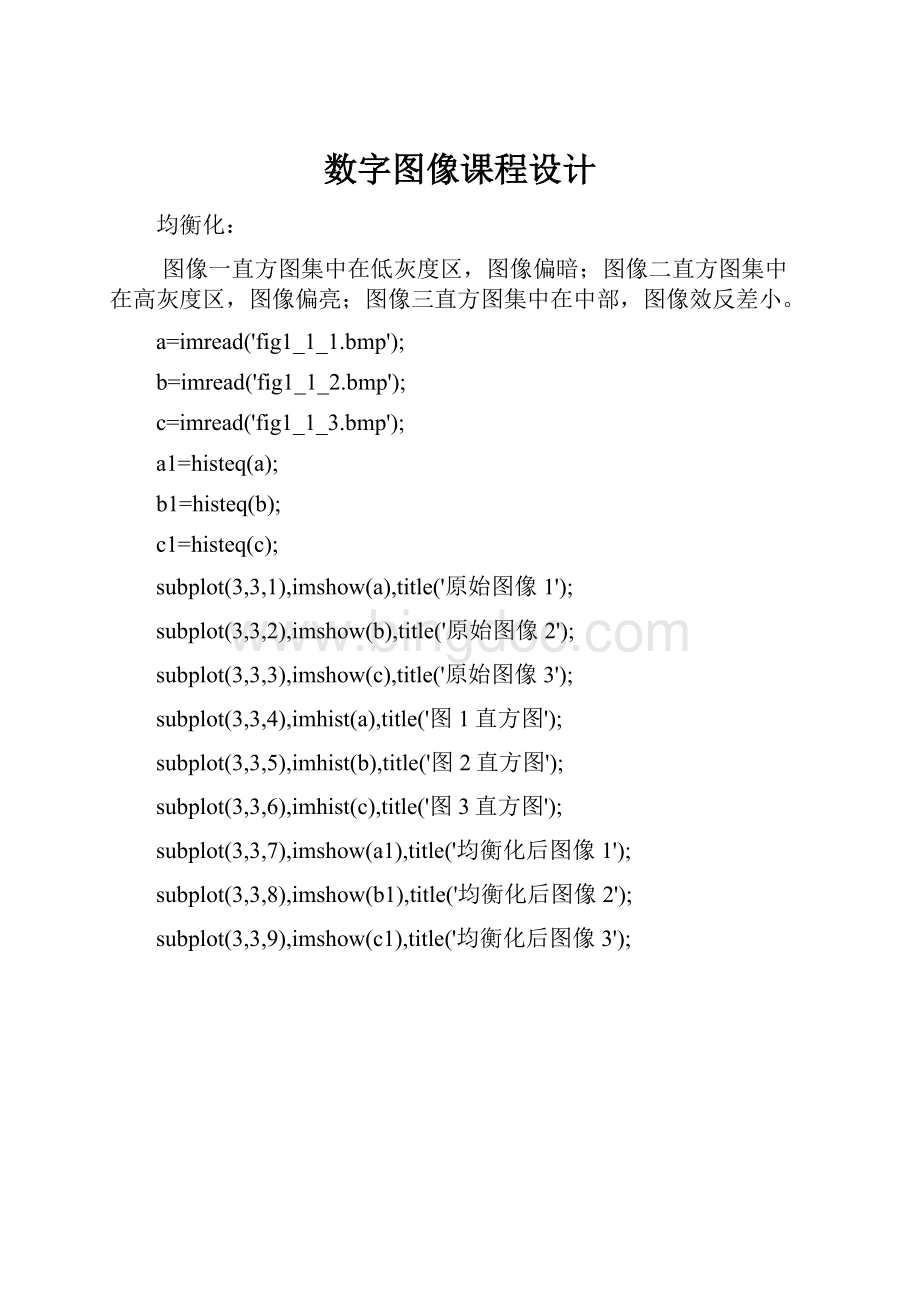数字图像课程设计.docx
《数字图像课程设计.docx》由会员分享,可在线阅读,更多相关《数字图像课程设计.docx(19页珍藏版)》请在冰点文库上搜索。

数字图像课程设计
均衡化:
图像一直方图集中在低灰度区,图像偏暗;图像二直方图集中在高灰度区,图像偏亮;图像三直方图集中在中部,图像效反差小。
a=imread('fig1_1_1.bmp');
b=imread('fig1_1_2.bmp');
c=imread('fig1_1_3.bmp');
a1=histeq(a);
b1=histeq(b);
c1=histeq(c);
subplot(3,3,1),imshow(a),title('原始图像1');
subplot(3,3,2),imshow(b),title('原始图像2');
subplot(3,3,3),imshow(c),title('原始图像3');
subplot(3,3,4),imhist(a),title('图1直方图');
subplot(3,3,5),imhist(b),title('图2直方图');
subplot(3,3,6),imhist(c),title('图3直方图');
subplot(3,3,7),imshow(a1),title('均衡化后图像1');
subplot(3,3,8),imshow(b1),title('均衡化后图像2');
subplot(3,3,9),imshow(c1),title('均衡化后图像3');
平滑滤波:
a=imread('fig1_2.bmp');
a1=imnoise(a,'salt&pepper',0.02);
l1=filter2(fspecial('average',3),a1)/255;
l2=filter2(fspecial('average',5),a1)/255;
l3=filter2(fspecial('average',7),a1)/255;
l4=filter2(fspecial('average',9),a1)/255;
figure
(1)
subplot(2,3,1),imshow(a),title('原始图像');
subplot(2,3,2),imshow(l1);title('3*3模板平滑滤波');
subplot(2,3,3),imshow(l2);title('5*5模板平滑滤波');
subplot(2,3,4),imshow(l3);title('7*7模板平滑滤波');
subplot(2,3,5),imshow(l4);title('9*9模板平滑滤波');
l11=filter2(fspecial('average',3),a)/255;
l22=filter2(fspecial('average',5),a)/255;
l33=filter2(fspecial('average',7),a)/255;
l44=filter2(fspecial('average',9),a)/255;
figure
(2)
subplot(2,3,1),imshow(a),title('原始图像');
subplot(2,3,2),imshow(a1),title('添加椒盐噪声的图像');
subplot(2,3,3),imshow(l11);title('3*3模板平滑滤波');
subplot(2,3,4),imshow(l22);title('5*5模板平滑滤波');
subplot(2,3,5),imshow(l33);title('7*7模板平滑滤波');
subplot(2,3,6),imshow(l44);title('9*9模板平滑滤波¨');
平滑滤波是低频增强的空间域滤波技术。
它的目的有两类:
一类是模糊;另一类是消除噪音。
空间域的平滑滤波一般采用简单平均法进行,就是求邻近像元点的平均亮度值。
在噪声均匀分布在边缘时,使用平滑滤波会有较大的误差,如果噪声不是均匀分布,可有效去除噪声。
邻域的大小与平滑的效果直接相关,邻域越大平滑的效果越好,但邻域过大,平滑会使边缘信息损失的越大,从而使输出的图像变得模糊,因此需合理选择邻域的大小。
锐化滤波:
i=imread('fig1_2.bmp');
f=[8];
g=[-1-1-1;-18-1;-1-1-1];m=[-1-1-1-1-1;-1-18-1-1;-1-1-1-1-1];
n=[-1-1-1-1-1-1-1;-1-1-18-1-1-1;-1-1-1-1-1-1-1];
p=[-1-1-1-1-1-1-1-1-1;-1-1-1-18-1-1-1-1;-1-1-1-1-1-1-1-1-1];
h=double(i);
e=conv2(h,f,'same');
j=conv2(h,g,'same');
x=conv2(h,m,'same');
y=conv2(h,n,'same');
z=conv2(h,n,'same');
subplot(2,3,1);imshow(h);title('原始图像');
subplot(2,3,2);imshow(e);title('滤波后图像1');
subplot(2,3,3);imshow(j);title('滤波后图像2');
subplot(2,3,4);imshow(x);title('滤波后图像3');
subplot(2,3,5);imshow(y);title('滤波后图像4');
subplot(2,3,6);imshow(z);title('滤波后图像5');
图像锐化处理的目的是为了使图像的边缘、轮廓线以及图像的细节变的清晰。
一般情况下,在计算机图像处理中可用微分运算和高通滤波器来实现图像的锐化。
空间域图像的锐化常用的是拉普拉斯运算,它不仅是偏导数的线性组合,而且是各向同性的,这样可以使图像中间任何方向伸展的边缘和轮廓线变得清晰
低通滤波:
I=imread('fig1_2.bmp');
[mnp]=size(I);
I=double(I);
subplot(2,2,1);image(I);colormap(gray),title('原始图');
Noise=wgn(m,n,25);
New=Noise+I;
subplot(2,2,2);image(New),title('噪声图');
g=fft2(New);
g=fftshift(g);
[M,N]=size(g);
nn=2;
d0=20;
m=fix(M/2);n=fix(N/2);
fori=1:
M
forj=1:
N
d=sqrt((i-m)^2+(j-n)^2);
h=1/(1+0.414*(d/d0)^(2*nn));
result(i,j)=h*g(i,j);
end
end
result=ifftshift(result);
J2=ifft2(result);
J3=uint8(real(J2));
subplot(2,2,3);image(J3),title('截止频率20');
nn=2;
d0=100;
m=fix(M/2);n=fix(N/2);
fori=1:
M
forj=1:
N
d=sqrt((i-m)^2+(j-n)^2);
h=1/(1+0.414*(d/d0)^(2*nn));
result(i,j)=h*g(i,j);
end
end
result=ifftshift(result);
J2=ifft2(result);
J3=uint8(real(J2));
subplot(2,2,4);image(J3),title('截止频率100')
去掉信号中不必要的高频成分,降低采样频率,避免频率混淆,去掉高频干扰
高通滤波:
I=imread('fig1_2.bmp');
[mnp]=size(I);
I=double(I);
subplot(2,2,1),image(I),colormap(gray);,title('原始图');
Noise=wgn(m,n,25);
New=Noise+I;
subplot(2,2,2);image(New),title('噪声图');
g=fft2(New);
g=fftshift(g);
[M,N]=size(g);
d0=15;
m=fix(M/2);n=fix(N/2);
fori=1:
M
forj=1:
N
d=sqrt((i-m)^2+(j-n)^2);
if(d<=d0)
h=0;
elseh=1;
end
result(i,j)=h*g(i,j);
end
end
result=ifftshift(result);
J1=ifft2(result);
J2=uint8(real(J1));
subplot(2,2,3),imshow(J2),title('IHPF滤波(d0=15)');
[M,N]=size(g);
d0=100;
m=fix(M/2);n=fix(N/2);
fori=1:
M
forj=1:
N
d=sqrt((i-m)^2+(j-n)^2);
if(d<=d0)
h=0;
elseh=1;
end
result(i,j)=h*g(i,j);
end
end
result=ifftshift(result);
J1=ifft2(result);
J2=uint8(real(J1));
subplot(2,2,4),imshow(J2),title('IHPF滤波(d0=100)');
高通滤波器衰减或抑制低频分量而通过高频分量。
图像的边缘、细节主要在高频部分得到反映。
而图像的模糊是高频部分较弱造成的。
为了消除模糊,突出图像的边缘信息,则采用高通滤波器让高频部分通过,消弱图像的低频成分,再经过傅里叶逆变换得到边缘锐化的图像。
图像还原:
I=imread('fig1_3_1.bmp');
subplot(2,2,1);imshow(I);title('模糊图像');
[m,n]=size(I);
F=fftshift(fft2(I));
k=0.0025;
foru=1:
m
forv=1:
n
H(u,v)=exp((-k)*(((u-m/2)^2+(v-n/2)^2)^(5/6)));
end
end
G=F.*H;
I0=real(ifft2(fftshift(G)));
I1=imnoise(uint8(I0),'gaussian',0,0.001)
subplot(2,2,2),imshow(uint8(I1)),title('模糊退化且添加高斯噪声的图像');
F0=fftshift(fft2(I1));
F1=F0./H;
I2=ifft2(fftshift(F1));
subplot(2,2,3),imshow(uint8(I2)),title('全逆滤波复原图');
K=0.1;
foru=1:
m
forv=1:
n
H(u,v)=exp(-k*(((u-m/2)^2+(v-n/2)^2)^(5/6)));H0(u,v)=(abs(H(u,v)))^2;
H1(u,v)=H0(u,v)/(H(u,v)*(H0(u,v)+K));
end
end
F2=H1.*F0;
I3=ifft2(fftshift(F2));
subplot(2,2,4),imshow(uint8(I3)),title('维纳滤波复原图');
形态学图像处理:
I1=imread('fig1_4_1.bmp');
I3=im2bw(I1);
Subplot(221),imshow(I1)
Subplot(222),imshow(I3)
I4=bwmorph(I3,'open');
Subplot(223),imshow(I4)
I5=bwmorph(I4,'close');
I=imread('fig1_4_2.bmp');
B=strel('diamond',1);
J1=imopen(I,B);
J2=imclose(J1,B);
subplot(1,2,1);imshow(I);title('原始图像');
subplot(1,2,2);imshow(J2);title('滤噪结果');
rgb=imread('fig1_5.bmp');
rgb=im2double(rgb);
r=rgb(:
:
1);
g=rgb(:
:
2);
b=rgb(:
:
3);
subplot(3,3,1),imshow(rgb),title('原始图像');
subplot(3,3,4),imshow(r),title('原始图像红色分量');
subplot(3,3,5),imshow(g),title('原始图像绿色分量');
subplot(3,3,6),imshow(b),title('原始图像蓝色分量');
num=0.5*((r-g)+(r-b));
symden;
fen=sqrt((r-g).^2+(r-g).*(g-b));
theta=acos(num./(fen+eps));
H=theta;
H(b>g)=2*pi-H(b>g);
H=H/(2*pi);
num=min(min(r,g),b);
fen=r+g+b;
fen(fen==0)=eps;
S=1-3.*num./fen;
H(S==0)=0;
I=(r+g+b)/3;
hsi=cat(3,H,S,I);
subplot(3,3,7),imshow(H),title('H');
subplot(3,3,8),imshow(S),title('S');
subplot(3,3,9),imshow(I),title('I');
I1=rgb2gray(rgb);
subplot(3,3,2),imshow(I1);
title('灰度图像');
k1=filter2(fspecial('average',3),I1)/255;
subplot(3,3,3),imshow(k1);title('平滑滤波图像');
图像的校正:
A=imread('fig3_1.bmp');
se=strel('ball',12,0);
BW=imdilate(A,se);´
BW2=bwmorph(BW,'thin',Inf);
[H,T,R]=hough(BW2);
P=houghpeaks(H,5);
lines=houghlines(BW2,T,R,P);
fork=1:
length(lines)
xy=[lines(k).point1;lines(k).point2];
end
m=(xy(2,2)-xy(1,2))/(xy(2,1)-xy(1,1));
M=atan(m);
M=M*180/3.14;
C=imrotate(A,M);
subplot(1,2,1);imshow(A);title('原图像');
subplot(1,2,2);imshow(C);title('校正后的图像');
图像融合:
X1=imread('fig4_1_a.jpg');
X2=imread('fig4_1_b.jpg');
X3=imread('fig4_1_c.jpg');
X4=imread('fig4_1_d.jpg');
X5=imread('fig4_1_e.jpg');
X6=imread('fig4_1_f.jpg');
subplot(3,2,1);imshow(X1);title('序列图像1');
subplot(3,2,2);imshow(X2);title('序列图像2');
subplot(3,2,3);imshow(X3);title('序列图像3');
subplot(3,2,4);imshow(X4);title('序列图像4');
subplot(3,2,5);imshow(X5);title('序列图像5');
subplot(3,2,6);imshow(X6);title('序列图像');
X1=double(X1);
X2=double(X2);
X3=double(X3);
X4=double(X4);
X5=double(X5);
X6=double(X6);
[c1,I1]=wavedec2(X1,3,'sym4');
[c2,I2]=wavedec2(X2,3,'sym4');
[c3,I3]=wavedec2(X3,3,'sym4');
[c4,I4]=wavedec2(X4,3,'sym4');
[c5,I5]=wavedec2(X5,3,'sym4');
[c6,I6]=wavedec2(X6,3,'sym4');
%对分解系数进行融合
c=c1+c2+c3+c4+c5+c6;
I=I1+I2+I3+I4+I5+I6;
c=0.001*(c1+c2+c3+c4+c5+c6);
%应用融合系数进行图像重构并显示
XX=waverec2(c,I1,'sym4');
figure;
XX=double(XX);
imshow(XX);title('融合图像');
图像压缩:
clear
I=imread('fig5_1.tif');
%该图片在安装matlab的目录中找,原图为灰度图象
I=im2double(I);%图像存储类型转换
T=dctmtx(8);%离散余弦变换矩阵
B=blkproc(I,[88],'P1*x*P2',T,T');%对原图像进行DCT变换
mask=[11110000
11100000
11000000
10000000
00000000
00000000
00000000
00000000];
B2=blkproc(B,[88],'P1.*x',mask);%数据压缩,丢弃右下角高频数据
I2=blkproc(B2,[88],'P1*x*P2',T',T);%进行DCT反变换,得到压缩后的图像
subplot(1,2,1),imshow(I),title('原始图像')
subplot(1,2,2),imshow(I2),title('压缩后的图像')
imwrite(I2,'cameraman_proc.tif')